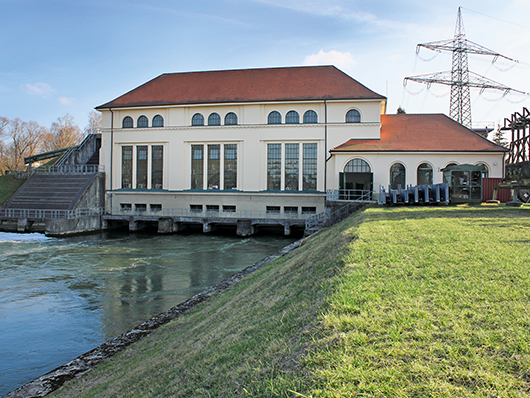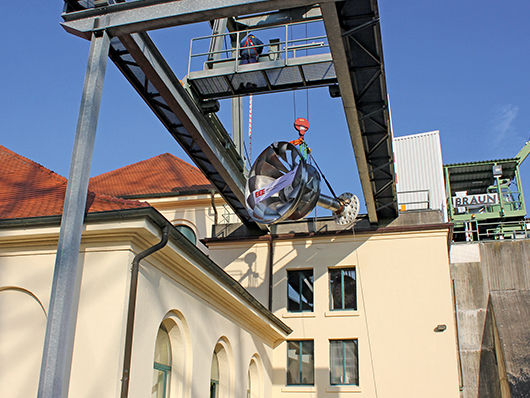Since starting the project, which began in 2015 and will run until 2017, two of the six impellers on the three twin Francis turbines have been replaced, the first machine is already in operation and work on the control systems and instrumentation technology is in full swing. An investigation at Graz University of Technology has meanwhile confirmed success with the agreed increase in efficiency.
With the construction of a three kilometre long channel parallel to the Lech, the origins of the Lech Canal were established in 1901 together with the Gersthofen power station. Today, the canal stretches 18 kilometres from Gersthofen to Meitingen. During the time that followed, two further Lech Canal power stations were built - the Langweid (1907) and Meitingen (1922) power stations. Each of these is now set to undergo extensive modernisation in succession, according to plans by Bayerische Elektrizitätswerke GmbH (BEW), a 100% subsidiary of Lechwerke AG (LEW) based in Augsburg.
For the experienced hydro power business unit of F.EE GmbH power engineering, Meitingen (installed capacity: 11,640 kW), alongside Langweid, is now the first Lech Canal power station to receive a comprehensive retrofit. The power plant, which is equipped with Francis turbines, is the second oldest of the BEW power stations on the Lech and takes top spot when it comes to annual power generation. In Gersthofen, where Kaplan turbines are in use, F.EE will be additionally modifying the bypass control and a head water flow rate controller, as well as the superimposed QW/Q control for the entire Lech Canal.
F.EE, the proprietor-operated company group with around 900 employees from Upper Palatinate, is one of Germany’s market leaders in production and automation technology and is divided up into the four company divisions electrical engineering, automation robotics, information technology + systems and power engineering. F.EE has been designing, programming and producing innovative switchgear and control systems for operating authorities of hydro power plants ranging in size from 20 kW to 20 MW and above for over 30 years now. The general contractor assignment for the Meitingen power plant is now the largest in the company’s almost 35-year history - calculated by order value.
Higher yield with the same drop height and discharge volume - that is the target that F.EE project leader Peter Fleischmann is now aiming for. By 2017, he and his team in Meitingen will be replacing all control systems, excitation devices and the power plant instrumentation technology and remote monitoring. In addition to the control and regulation units from the SIMATIC S7 series, a redundant SCADA system based on Siemens WinCC will also be used for the operation and monitoring of the complete power plant, which was specially developed for the requirements and applications of the operator. Using the new instrumentation technology, it is possible to monitor and operate the newly supplied equipment, such as the power plant general control, head water flow rate controller (OW/Q), bypass controls, the three turbine controls and the static excitation devices, as well as the generator protection and synchronisation. This also applies to all remaining existing systems, such as the 400V-AC, 24 and 110V-DC and the 20kV medium-voltage switchgear system, which will be replaced by the operator. Regulation systems developed by F.EE and tried and tested many times over are being used for the turbine control and OW/Q regulation.
Within the framework of the modernisation projects, a water balance control was developed for the entire Lech Canal under the leadership of Professor Stephan Theobald (Technical University (TU) Kassel, faculty for hydraulic engineering and water management). The resultant findings will be taken into consideration in the OW/Q controls to be supplied by F.EE at the individual sites and in a superordinate OW/Q control for the canal.
F.EE has commissioned Kochendörfer Wasserkraftanlagen from Pleystein - a company with many years of experience in machine technology - with supplying the six new improved-efficiency impellers, the separation of the guide vanes at turbine 1 and the necessary overhaul works for the three machine groups. The company is also responsible for the hydraulic aggregates, as well as the cooling and lubrication systems. With this, safety against faults will be significantly increased and the overhaul intervals extended. “Particularly important here is the use of high quality components and experience in the area of hydro power technology”, explains the project leader.
The impellers with a diameter of 2.4 metres are characterised in particular by an optimisation of the cavitation behaviour in accordance with IEC 609. With their improved efficiency together with the optimised control and OW/Q regulation of the turbine operation, as well as the division of the guide vane of turbine 1, they should deliver a significant increase in yield of over 10 percent per annum - a decisive order detail in the F.EE overall concept for the modernisation of the power plant.
Within the scope of the project, an increase in efficiency was contractually agreed. The Institute of Hydraulic Fluid Machinery of the Graz University of Technology (TU) has already verified and confirmed this through measurements on one of the renewed machines in accordance with IEC 60041. A success that has confirmed the decision of the customer BEW in favour of F.EE, and one that delights Peter Fleischmann in particular: “Thanks to our expertise and the experience of our partner, with this project we have once again succeeded in demonstrating that we are able to set the benchmark when it comes to energy and power plant technology. The focus on our own software solutions for regulation and control engineering, together with our proven know-how in switchgear cabinet construction, mean that we and our solutions are superbly well positioned competitively for further large-scale projects - also as a general contractor.”
The works on the Meitingen power plant are still in full swing, in order that the last of the three machines can be commissioned in December 2016 in accordance with the target. Pre-planning is currently also taking place for the follow-up projects in Langweid and Gersthofen, which are set to take place from 2017. For the operating authority BEW and the owner LEW, which also runs the popular Lech Museum Bayern at the Langweid hydro power station - with its accessible historic turbine chamber and modern presentation of information on the nature, culture and history of the Lech, this is a sustainable and promising investment in the future.


